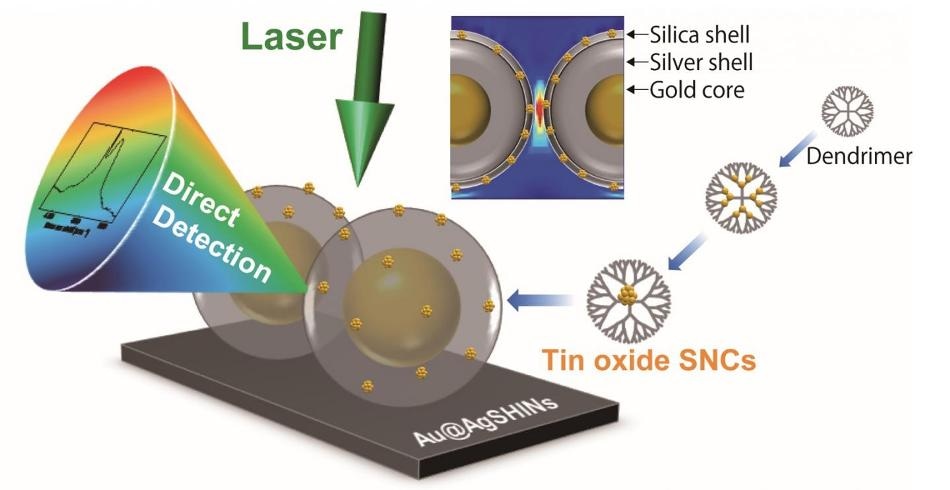Dec 16 2019
A novel method, developed by researchers at Tokyo Institute of Technology (Tokyo Tech), enables scientists to evaluate the structure and chemical composition of metallic particles that have a diameter of just 0.5 to 2 nm.
 Tin oxide SNCs, finely prepared by a dendrimer template method, are loaded on the thin silica shell layers of plasmonic amplifiers, such that the Raman signals of the SNCs are substantially enhanced to a detectable level. The strength of the electromagnetic fields generated due to the surface plasmon resonance properties of the Au or Ag nanoparticles decays exponentially with distance from the surface. Therefore, a rational interfacial design between the amplifiers and SNCs is the key to acquiring strong Raman signals. Image Credit: Science Advances.
Tin oxide SNCs, finely prepared by a dendrimer template method, are loaded on the thin silica shell layers of plasmonic amplifiers, such that the Raman signals of the SNCs are substantially enhanced to a detectable level. The strength of the electromagnetic fields generated due to the surface plasmon resonance properties of the Au or Ag nanoparticles decays exponentially with distance from the surface. Therefore, a rational interfacial design between the amplifiers and SNCs is the key to acquiring strong Raman signals. Image Credit: Science Advances.
Thanks to this latest advancement in analytical methods, tiny materials can be developed and used in the fields of chemistry, biomedicine, and electronics, to name a few.
The analysis and development of innovative materials have allowed an unlimited number of technological innovations and are crucial across many fields of science, ranging from bioengineering and medicine to state-of-the-art electronics.
The practical design as well as analysis of novel materials at nanoscopic scales helps in overcoming the limitations of earlier methodologies and devices to achieve new capabilities and unparalleled levels of efficiency.
The same is the case for metal nanoparticles, which have presently attracted a great deal of attention in contemporary research due to their range of promising applications.
A newly developed synthesis technique that involves the use of dendrimer molecules as a template enables scientists to produce metallic nanocrystals that have diameters ranging between 0.5 and 2 nm, that is, billionths of a meter.
These remarkably tiny particles, known as “subnano clusters” (SNCs), have extremely distinctive characteristics like exhibiting unusual quantum phenomena that are highly susceptible to variations in the number of constituent atoms of the clusters and being exceptional catalyzers for (electro)chemical reactions.
Regrettably, the prevailing analytical techniques used for analyzing the structure of particles and materials at the nanoscale are not suited for detecting SNCs.
Raman spectroscopy is one such technique in which a sample is irradiated with a laser and the resulting scattered spectra are analyzed to achieve a molecular profile or fingerprint of the potential components of the material.
Conventional Raman spectroscopy and its variants have served as useful tools for scientists, but they tend to have low sensitivity and hence cannot be utilized for SNCs.
Consequently, a team of researchers from Tokyo Tech, which included Dr Akiyoshi Kuzume, Professor Kimihisa Yamamoto, and collaborators, has analyzed a method to improve Raman spectroscopy measurements and render them capable for SNC analysis.
Surface-enhanced Raman spectroscopy is one specific type of Raman spectroscopy method that has an additionally refined variant in which nanoparticles of gold and/or silver surrounded in a thin, inert silica shell are mixed with the sample to increase optical signals and consequently increase the method’s sensitivity.
The researchers initially focused on theoretically establishing the optimal composition and size of the nanoparticles, where silver optical amplifiers of 100 nm (nearly double the size utilized in general) can considerably increase the signals of the SNCs that are bound to the porous silica shell.
This spectroscopic technique selectively generates Raman signals of substances that are in close proximity to the surface of the optical amplifiers.
Kimihisa Yamamoto, Professor, Tokyo Institute of Technology
To test these findings, the researchers quantified the Raman spectra of tin oxide SNCs to check whether an explanation could be found in their structural or chemical composition for their enigmatically high catalytic activity in specific chemical reactions.
When the researchers compared their Raman measurements with theoretical analyses and structural simulations, they gained a new understanding of the structural composition of the tin oxide SNCs that explained the origin of the specific, atomicity-reliant catalytic activity of tin oxide SNCs.
The method used in this study can have major implications for developing better subnanoscale science and analytical methods.
Detailed understanding of the physical and chemical nature of substances facilitates the rational design of subnanomaterials for practical applications. Highly sensitive spectroscopic methods will accelerate material innovation and promote subnanoscience as an interdisciplinary research field.
Kimihisa Yamamoto, Professor, Tokyo Institute of Technology
Innovations such as the one demonstrated by the researchers will be useful for extending the scope of using subnanomaterials in numerous fields such as catalysts, electronics, and biosensors.
Source: https://www.titech.ac.jp/english/